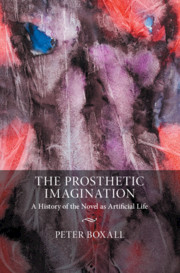Book contents
- The Prosthetic Imagination
- The Prosthetic Imagination
- Copyright page
- Dedication
- Epigraph
- Contents
- Illustrations
- Acknowledgements
- Introduction
- Part I The Body and the Early Modern State: From More to Cavendish
- Part II The Colonial Body: From Behn to Goethe
- Part III The Manufactured Body: From Wollstonecraft to Stoker
- Part IV The Modernist Body: From James to Beckett
- Chapter 6 A Duplication of Consciousness: Realism, Modernism and Prosthetic Self-Fashioning
- Chapter7 All Twined Together: Prosthetic Modernism from Proust to Beckett
- Part V The Posthuman Body: From Orwell to Atwood
- Notes
- Bibliography
- Index
Chapter 6 - A Duplication of Consciousness: Realism, Modernism and Prosthetic Self-Fashioning
from Part IV - The Modernist Body: From James to Beckett
Published online by Cambridge University Press: 18 September 2020
- The Prosthetic Imagination
- The Prosthetic Imagination
- Copyright page
- Dedication
- Epigraph
- Contents
- Illustrations
- Acknowledgements
- Introduction
- Part I The Body and the Early Modern State: From More to Cavendish
- Part II The Colonial Body: From Behn to Goethe
- Part III The Manufactured Body: From Wollstonecraft to Stoker
- Part IV The Modernist Body: From James to Beckett
- Chapter 6 A Duplication of Consciousness: Realism, Modernism and Prosthetic Self-Fashioning
- Chapter7 All Twined Together: Prosthetic Modernism from Proust to Beckett
- Part V The Posthuman Body: From Orwell to Atwood
- Notes
- Bibliography
- Index
Summary
This chapter traces the emergence of a prosthetic modernism in the late nineteenth and early twentieth centuries. It suggests that the literature of the fin de siècle, from Bellamy and Wells to Gilman and Wilde, registers a shifted relation between the interior and the exterior of being and between the figurations of surface and depth in the artwork, produced by the development of a new period in the history of modernity. This shifted relation is discernible in the late-century realism, but it is in the first stirrings of the modernist form that it comes to a new kind of expression. The chapter reads this new modernist relation between inside and outside, between surface and depth, as it is given expression in the novels of Edith Wharton and Henry James, particularly in The House of Mirth, and in What Maisie Knew. These works depict a duplication of consciousness, a sense that the novel imagination encounters itself always at remove from itself, but they also produce a new formal means of giving this duplicated consciousness a unity, of bringing depths onto the modernist surface of the artwork.
- Type
- Chapter
- Information
- The Prosthetic ImaginationA History of the Novel as Artificial Life, pp. 225 - 257Publisher: Cambridge University PressPrint publication year: 2020

